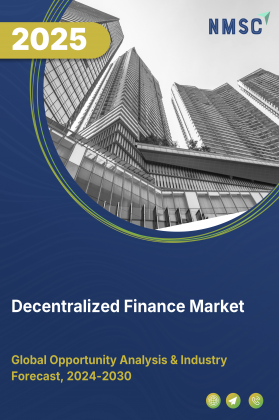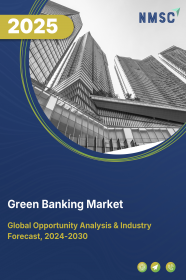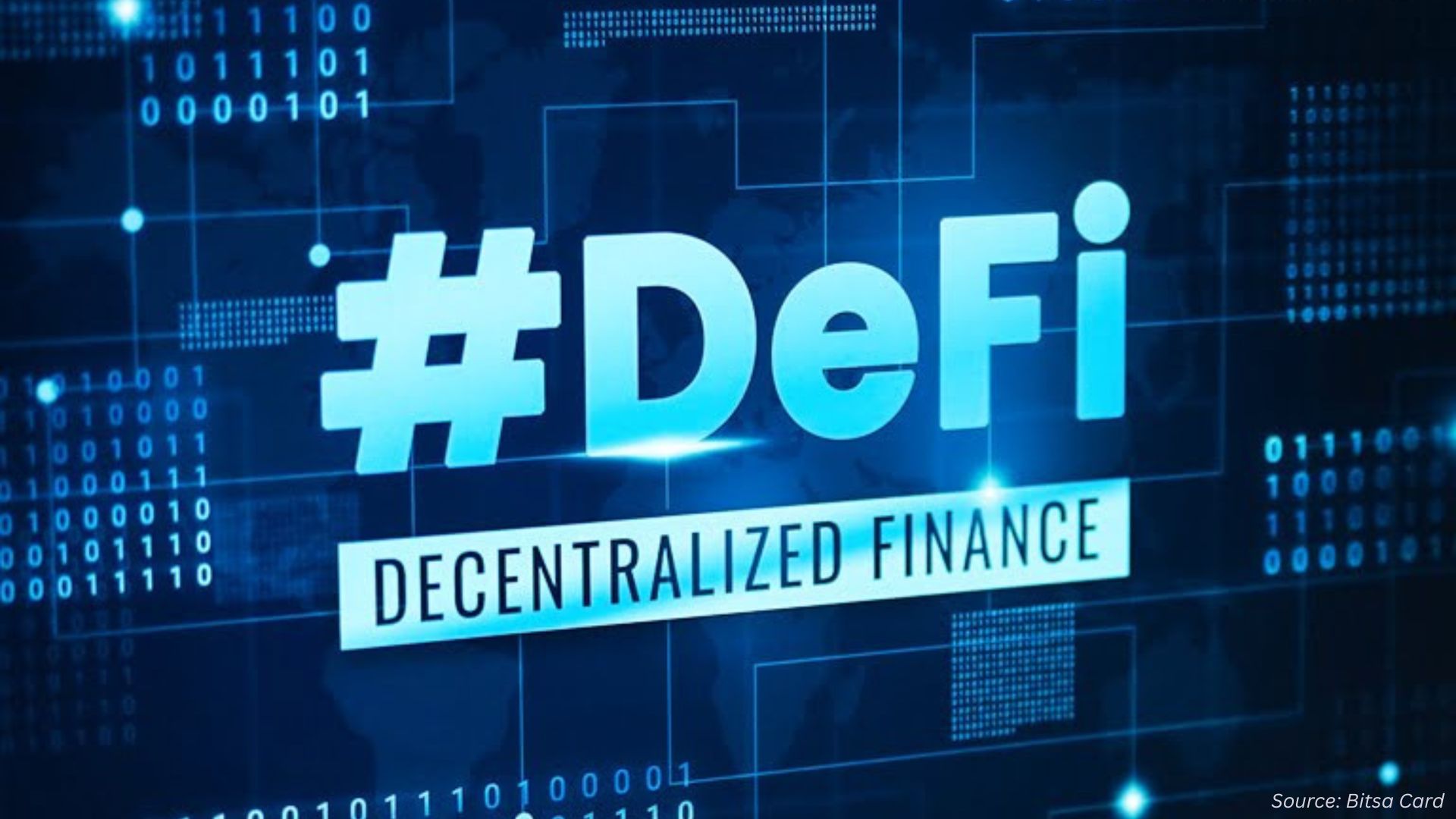
Decentralized Finance Market by Component (Smart Contracts, Blockchains, L2 Scaling Solutions), by Product (Decentralized Exchanges including Spot Trading, Liquidity Pools & AMMs, Lending & Borrowing protocols, Stablecoins & Payments), by Regulatory Status (Unregulated, Compliant, Legal Wrappers), by End-User (Institutional Participants, Developers & Protocol Teams, Liquidity Providers & Market Makers) – Global Opportunity Analysis and Industry Forecast, 2025–2030
Industry Overview
The global Decentralized Finance Market size was valued at USD 29.05 billion in 2024 and is predicted to reach USD 44.79 billion by the end of 2025. The industry is predicted to reach USD 390.47 billion by 2030 with a CAGR of 54.2% from 2025 to 2030.
The market is rapidly growing, driven by increasing demand for financial inclusion among unbanked and underbanked populations worldwide. By leveraging blockchain technology, DeFi platforms offer open, permissionless financial services that overcome traditional banking barriers, enabling users to access lending, borrowing, and investment opportunities globally.
Rising cryptocurrency adoption further boosts market demand by providing the foundational infrastructure for seamless, peer-to-peer transactions. Additionally, growing institutional interest and investment bring liquidity, innovation, and regulatory momentum, enhancing market maturity and acceptance.
However, security vulnerabilities in smart contracts remain a key challenge, deterring some users and investors. Despite this, expanding DeFi services into emerging markets presents significant growth opportunities by addressing financial accessibility gaps, supported by increasing internet and smartphone penetration. This dynamic environment positions DeFi as a transformative force reshaping the global financial ecosystem.
Growing Demand for Financial Inclusion Drives the Market Growth
A significant driver of the decentralized finance market growth is the increasing demand for financial inclusion, especially among the unbanked and underbanked populations worldwide. Traditional financial systems exclude large segments of people due to factors like lack of access to banks, high fees, stringent documentation requirements, or geographic limitations.
DeFi platforms leverage blockchain technology to provide open and permissionless financial services, allowing anyone with an internet connection to participate. This democratization of finance empowers individuals in remote or underserved regions to access lending, borrowing, savings, and investment opportunities without intermediaries.
As awareness and adoption grow, DeFi’s ability to bridge gaps in the traditional financial ecosystem fuels market expansion and attracts a diverse user base, further accelerating the development of innovative financial products.
Increasing Institutional Interest and Investment Fuels the Market Expansion
The growing interest and participation of institutional investors in the decentralized finance market demand, is a major catalyst driving its expansion. As DeFi protocols mature and demonstrate robust security and scalability, institutions such as hedge funds, venture capital firms, and asset managers are recognizing DeFi as a promising avenue for portfolio diversification and yield generation. This influx of institutional capital not only provides liquidity and stability to the market but also drives innovation through strategic investments and partnerships.
Furthermore, increased institutional involvement encourages regulatory clarity and professionalizes the ecosystem, making DeFi more attractive to a broader audience. Overall, institutional adoption signals growing confidence in DeFi’s potential, accelerating industry growth and fostering mainstream acceptance.
Rising Adoption of Cryptocurrencies Boost the Market Demand
The increasing acceptance and use of cryptocurrencies worldwide serve as a key driver for the growth of the market. As more individuals and businesses embrace digital currencies like Bitcoin, Ethereum, and various altcoins, the demand for decentralized financial services built on these assets rises in tandem.
Cryptocurrencies provide the foundational infrastructure for DeFi platforms, enabling peer-to-peer transactions, lending, borrowing, and trading without intermediaries. Greater cryptocurrency adoption increases the liquidity and utility of DeFi protocols, encouraging developers to create innovative applications and attracting a wider user base. This positive feedback loop between cryptocurrency adoption and DeFi expansion helps push the market toward mainstream recognition and integration with the global financial ecosystem.
Security Vulnerabilities and Smart Contract Risks Hinders the Market Growth
Security concerns pose a significant restraint on the growth of the market. DeFi platforms rely heavily on smart contracts, self-executing code that automates financial transactions. However, these smart contracts have bugs, vulnerabilities, or coding errors that hackers exploit, leading to loss of funds or system manipulation.
High-profile hacks, exploits, and rug pulls have raised concerns about the safety and reliability of DeFi protocols. Additionally, because DeFi is largely decentralized and anonymous, recovering stolen assets or holding perpetrators accountable is challenging. These risks deter potential users and institutional investors, limiting wider adoption until more robust security measures and audits become standard practice.
Expansion into Emerging Markets and Unbanked Populations Unlocks New Growth Opportunities
The market holds significant opportunity in expanding access to financial services in emerging economies and among unbanked or underbanked populations. Many regions, especially in developing countries, face barriers such as limited banking infrastructure, high transaction costs, and lack of financial literacy. DeFi platforms, accessible via smartphones and the internet, overcome these challenges by offering low-cost, borderless financial services like loans, savings, insurance, and payments.
As internet penetration and smartphone adoption increase globally, DeFi tap into these vast underserved markets, driving massive user growth and transforming financial inclusion. This expansion not only grows the DeFi user base but also encourages innovation in localized financial products tailored to diverse economic needs.
Market Segmentations and Scope of the Study
The decentralized finance market report is segmented by component, product, regulatory status, end-user, and region. Components include smart contracts, blockchains, layer-2 scaling solutions, oracles, middleware, bridges, interoperability layers, and custody solutions. Products cover decentralized exchanges, lending and borrowing protocols, stablecoins and payment systems, derivatives and synthetic assets, yield products and staking services, asset tokenization, insurance protocols, asset management, oracles, and infrastructure tools. End users consist of retail users, institutional participants, developers, liquidity providers, market makers, and payment and remittance users. Geographically, the market is analysed across North America, Europe, Asia-Pacific, and the Rest of the World, reflecting strong adoption and growth across diverse regions and sectors.
Geographical Analysis
In North America, one of the primary drivers of the decentralized finance market share is the region’s strong culture of technological innovation and early adoption. The presence of leading blockchain technology companies, fintech startups, and a tech-savvy population creates a fertile environment for the rapid development and adoption of DeFi solutions.
Additionally, access to venture capital funding and robust infrastructure supports continuous innovation and scaling of DeFi platforms. This environment encourages experimentation with new financial products, smart contracts, and decentralized applications, driving market growth and positioning North America as a key hub for DeFi advancements globally.
Europe’s market is driven by its progressive regulatory environment and strong emphasis on financial innovation. Several European countries and the European Union are actively working on clear regulatory frameworks that balance investor protection with fostering blockchain and DeFi innovation.
Initiatives like the EU’s Markets in Crypto-Assets (MiCA) regulation aim to provide legal clarity, boosting investor confidence and encouraging mainstream adoption. Moreover, Europe’s well-established financial hubs and collaborative fintech ecosystems facilitate partnerships between traditional finance and DeFi startups, accelerating product development and market growth.
The Asia-Pacific region’s market is strongly driven by rapid digital adoption alongside a sizable unbanked and underbanked population. Increasing smartphone penetration and improving internet infrastructure enable millions to access decentralized financial services for the first time.
Many countries in the region face challenges with traditional banking access, making DeFi solutions attractive for lending, savings, and cross-border payments. Additionally, supportive government initiatives in fintech innovation and blockchain technology adoption further fuel DeFi growth, positioning Asia-Pacific as a high-potential market for decentralized finance.
In many developing regions across the Rest of the World (RoW), including Africa, the Middle East, and other underserved areas, a key driver for the market is the high demand for affordable and accessible financial services. Traditional banking systems fail to reach remote or underserved populations due to limited infrastructure and high operational costs.
DeFi platforms, leveraging blockchain technology, provide low-cost, borderless financial solutions that anyone with internet access use. This accessibility empowers individuals and small businesses by offering services such as lending, savings, and payments without the need for intermediaries, driving DeFi adoption and market growth in these regions.
Strategic Innovations Adopted by Key Players
Key players in the decentralized finance industry are actively driving protocol innovation, strategic integrations, and ecosystem expansion to enhance composability, cross-chain functionality, and institutional appeal.
-
In June 2025, Aave Labs continued steady progress on multiple protocol initiatives aligned with its role as a service provider, with Aave V4 development as its primary focus. The team also supported funding for projects like GHO stablecoin allocations, enhanced interface features, and integrations with assets such as cbETH and wstETH on Base. Additionally, proposed collaborations involving CDP and Uniswap aim to expand composability, cross-chain functionality, and the stablecoin ecosystem—further strengthening Aave’s protocol resilience and institutional appeal.
-
In December 2024, Balancer shipped v3, introducing Custom Pools and Hooks, and secured key integrations such as with Aave for Boosted Pools. The v3 release focused on developer experience improvements and boosted pool mechanics designed to attract large liquidity providers and strategic partnerships. These enhancements aim to increase swap volume and total value locked, positioning Balancer as a programmable automated market maker and a foundational liquidity layer for the broader DeFi ecosystem.
Key Benefits
-
The report provides quantitative analysis and estimations of the industry from 2025 to 2030, which assists in identifying the prevailing market opportunities.
-
The study comprises a deep-dive analysis of the current and future decentralized finance market trends to depict prevalent investment pockets in the sector.
-
Information related to key drivers, restraints, and opportunities and their impact on the market is provided in the report.
-
Competitive analysis of the key players, along with their market share is provided in the report.
-
SWOT analysis and Porters Five Forces model is elaborated in the study.
-
Value chain analysis in the market study provides a clear picture of roles of stakeholders.
Decentralized Finance Market Key Segments
By Component
-
Smart contracts
-
Blockchains
-
L2 scaling solutions
-
Oracles & middleware
-
Bridge & interoperability layers
-
Custody & key-management solutions
By Product
-
Decentralized exchanges
-
Spot trading
-
Liquidity pools & AMMs
-
Orderbook DEXs
-
-
Lending & Borrowing protocols
-
Overcollateralized lending
-
Under-collateralized
-
Flash loans
-
-
Stablecoins & Payments
-
Crypto-native stablecoins
-
Fiat-backed stablecoins
-
Payment rails, wallets & remittances
-
- Derivatives & Synthetic Assets
-
Perpetuals, futures, options
-
Synthetic tokenized assets
-
- Yield products & Staking Services
-
Yield aggregators & vaults
-
Liquid staking services
-
-
Asset Tokenization & Real-World Assets
-
Insurance, Risk & Coverage protocols
-
Asset Management & Indexing
-
Oracles & Data Services
-
Infrastructure & Tooling
By Regulatory
-
Unregulated
-
Compliant
-
legal wrappers
By End-User
-
Retail users
-
Institutional participants
-
Developers & protocol teams
-
Liquidity providers and market makers
-
Payment & remittance users
By Region
-
North America
-
The U.S.
-
Canada
-
Mexico
-
-
Europe
-
The UK
-
Germany
-
France
-
Italy
-
Spain
-
Denmark
-
Netherlands
-
Finland
-
Sweden
-
Norway
-
Russia
-
Rest of Europe
-
-
Asia-Pacific
-
China
-
Japan
-
India
-
South Korea
-
Australia
-
Indonesia
-
Singapore
-
Taiwan
-
Thailand
-
Rest of Asia-Pacific
-
-
RoW
-
Latin America
-
Middle East
-
Africa
-
Key Players
-
Aave Protocol / Aave (Aave Labs)
-
Uniswap Labs
-
MakerDAO / Maker (Sky)
-
Yearn Finance
-
Synthetix
-
Frax
-
Rocket Pool Pty Ltd.
-
GMX
-
1inch
-
Balancer
-
JustLend DAO
-
Alchemix Labs
-
Liquity AG
-
Bancor
REPORT SCOPE AND SEGMENTATION:
|
Parameters |
Details |
|
Market Size in 2025 |
USD 44.79 Billion |
|
Revenue Forecast in 2030 |
USD 390.47 Billion |
|
Growth Rate |
CAGR of 54.2% from 2025 to 2030 |
|
Analysis Period |
2024–2030 |
|
Base Year Considered |
2024 |
|
Forecast Period |
2025–2030 |
|
Market Size Estimation |
Billion (USD) |
|
Growth Factors |
|
|
Countries Covered |
28 |
|
Companies Profiled |
15 |
|
Market Share |
Available for 10 companies |
|
Customization Scope |
Free customization (equivalent up to 80 working hours of analysts) after purchase. Addition or alteration to country, regional, and segment scope. |
|
Pricing and Purchase Options |
Avail customized purchase options to meet your exact research needs. |

















 Speak to Our Analyst
Speak to Our Analyst






















